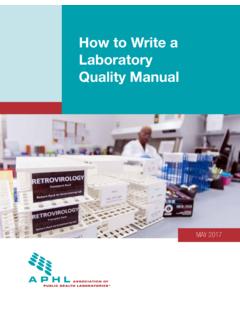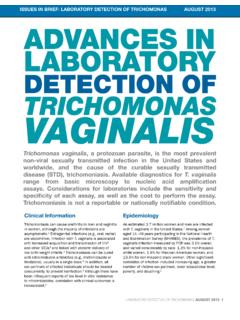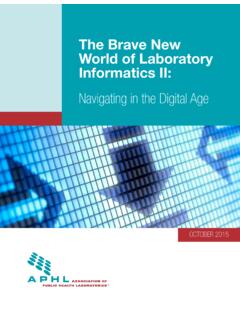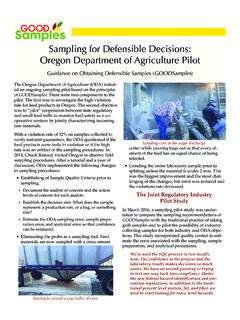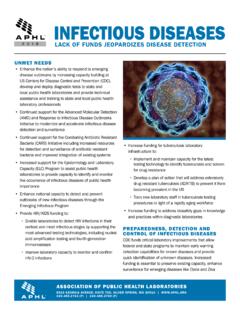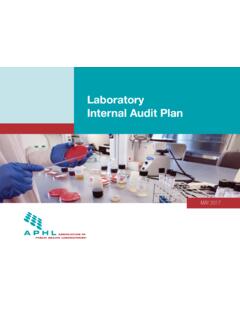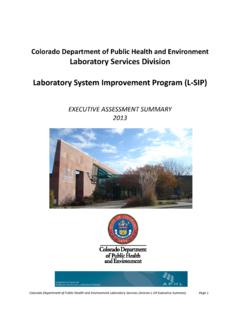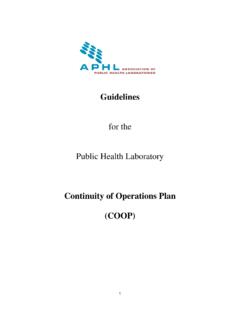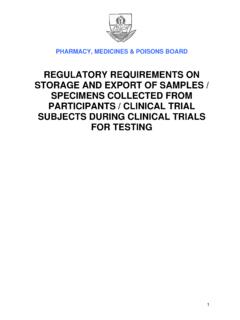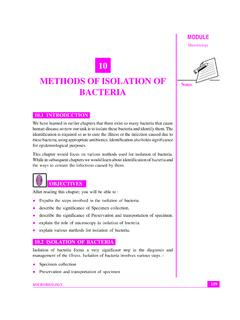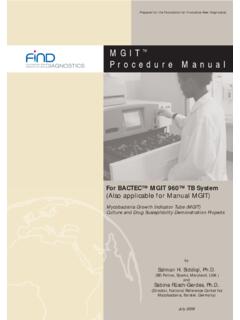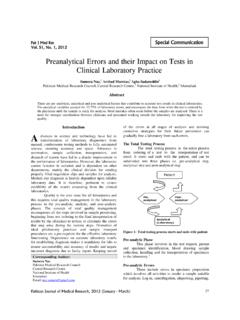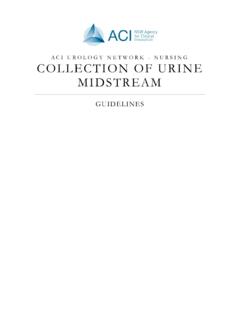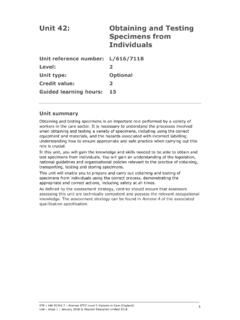Transcription of Specimen Collection, Handling, Transport and Processing
1 Specimen collection , handling , Transport and Processing Specimen collection , handling , and Transport Notes: This training module will discuss the aspects of Specimen collection , handling and Transport as they relate to TB testing. Specimen Quality Is Important Notes: As with all laboratory testing, it is critical that the Specimen submitted be of high quality in order to obtain the highest quality result. APHL has developed a tool to help you assess various aspects of TB testing in your lab. Ensuring quality specimens is included in this tool and the website is included on this slide. Working with Healthcare Providers Notes: Specimen quality begins of course with collection . Health care providers, who are either collecting specimens or instructing patients on how to collect specimens, must clearly understand proper collection methods and how suboptimal collection procedure will affect the result they ultimately use to treat their patient.
2 It is important to build good working relationships with health care providers. Laboratories also should have a reference manual for providers that includes: Specimen type and volume requirements; Specimen collection , labeling, storage and Transport instructions; and Specimen rejection criteria. When the lab does identify persistent issues with specimens submitted, they should provide feedback to the provider. Specimen Types Notes: This slide shows Specimen types considered acceptable for the isolation of Mycobacterium tuberculosis. The CLSI M48-A document, Laboratory Detection and Identification of Mycobacteria should be available in your laboratory and it provides a great resource as a comprehensive list of Specimen types and recommendations for collection and transportation.
3 2. Respiratory (Pulmonary) Specimens Notes: Now, let's take a look at respiratory specimens. Sputum Notes: Sputum is the most common Specimen submitted for the detection and isolation of Mycobacterium tuberculosis. Sputum comes from a deep productive cough and should contain minimal amounts of oral and nasal material. Sputum can be submitted for several purposes: to establish an initial diagnosis of tuberculosis, to monitor the infectiousness of a patient, and to determine the effectiveness of treatment. Sputum Quality Notes: A good sputum Specimen will be thick and contain mucoid and mucopurulent material as depicted by the Specimen shown on the right. Suboptimal specimens should either be rejected or the results should have a qualifying statement attached.
4 Even good quality sputum specimens of volume less than 3-5 MLs will not give the best results, so negative results obtained from these specimens should have a qualifying statement attached. Sputum specimens that are induced may actually appear thinner and less purulent than a good expectorated sputum. Therefore the lab requisition should indicate when a Specimen is induced, so it is not rejected as saliva. Sputum Quality Notes: Here we see different sputum specimens ranging from a good sputum, seen on the upper left, all the way down to one containing saliva. Saliva, of course, is not an acceptable Specimen for tuberculosis testing. Indications for Sputum collection Notes: The guidelines for frequency of collection for sputum specimens that will be used for initial diagnosis have changed slightly.
5 The most recent MMWR recommendations now say that three sputum specimens should be collected at least 8 hours apart with one of them being a first morning Specimen . First morning specimens are usually considered best for AFB smears since mucus has had the opportunity to collect and concentrate in the lungs overnight. Laboratorians need to explain to physicians that may routinely send less than three specimens per patient why it is important for treatment. As with other specimens submitted for culture the specimens should be collected prior to the initiation of drug therapy. If a patient is on treatment, sputum should be tested until there are three negative smears. When monitoring patients for the effectiveness of therapy, sputum collection should start at least monthly until the cultures convert to negative.
6 Specimen collection : All Aerosol-Producing Procedures Pose a Risk of Exposure Notes: Infectious aerosols are three to five microns in size, and can stay in the air for hours. The greatest risk of TB is from these infectious aerosols. The aerosol is produced as a patient talks, coughs, sings, or sneezes are well recognized as requiring containment. So, this applies to Specimen collection as well, whether it be sputum collection or bronchoscopy. When a patient is suspected or confirmed to have tuberculosis, airborne precautions must be used. Specimen collection Notes: Patients suspected of or having TB must be housed in a negative pressure room and everyone who enters the room must use an N-95 respirator.
7 This is especially important during Specimen collection . Since we are using respirators, it's important to know that OSHA requires an employer to have a written respirator protection plan and each worker who is assigned to wear a respirator must receive a fit test before the worker is required to wear the respirator in the workplace. And, they must perform a seal check with each use. Fit testing is actually repeated annually. All specimens collected for mycobacteria testing must be collected in a sealed leak proof container. Storage and Transport of Sputum Specimens Notes: Standard recommendations for most microbiology specimens are that if the Specimen cannot be processed within one to two hours of collection , they must be refrigerated.
8 Additionally the Specimen should ideally reach the laboratory within 24 hours of collection and be kept cold during Transport . It is important that the submitter know to avoid batch shipment. Don't let them collect all three specimens on a patient and ship them at once. They should ship them as they are collected. Pulmonary Specimens Other than Sputum: Notes: There are respiratory and pulmonary specimens other than sputum that are acceptable for the diagnosis of TB. The most common ones submitted are bronch lavages and bronch brushes. As you can see, the minimum volume requirement for these specimens is 3mL, and refrigeration is recommended when there will be a delay from collection to Processing . The reason for the refrigeration, or keeping the Specimen cold, is to prevent overgrowth of other bacteria and normal flora that may be present.
9 These organisms can quickly outgrow Mycobacterium tuberculosis and make it more difficult to isolate, because the doubling time for other common respiratory flora is 15 to 20 minutes, whereas the doubling time for Mycobacterium Tuberculosis is 12 to 24 hours. 3. Non-Respiratory (Extrapulmonary) Specimens Notes: Now, let's take a look at extrapulmonary specimens that can be submitted for the isolation of M. Tuberculosis. Extrapulmonary Specimens Notes: The laboratory should expect to receive a variety of extrapulmonary specimens which may be divided into two groups. Those that are collected from non-sterile body sites, and those that are collected from normally sterile body sites. Once again, they all should be collected in a sterile leakproof container, and they should be transported as soon as possible.
10 Now, a swab is always an inferior Specimen type. The highest quality results will be obtained by using an aspirate or a piece of tissue. Education of physicians on the need to submit fluid or tissue as opposed to a swab should be standard practice for all specimens submitted for culture. Additionally, it might be helpful to get in touch with nurses in surgical suites, and let them know they should not to hand the physician a swab for Specimen collection . If there are no policies in place for correcting collection issues, the focus should be on targeted, consistent education for the physicians or other health care providers. Extrapulmonary Specimen collection Guidance Notes: So, let's look at some Specimen collection guidance for these extrapulmonary specimens.
